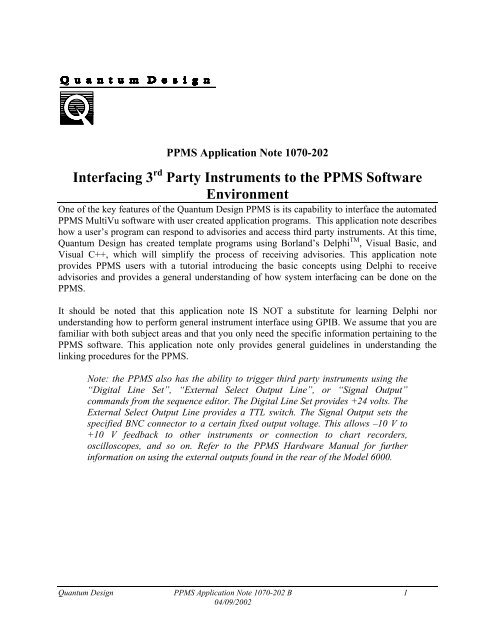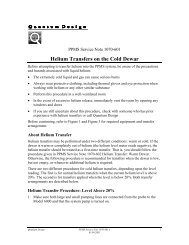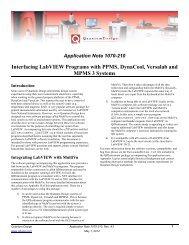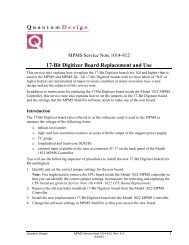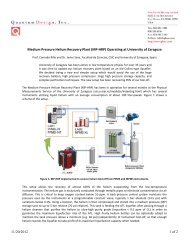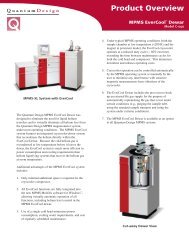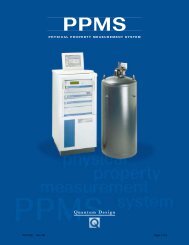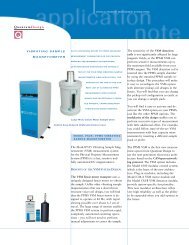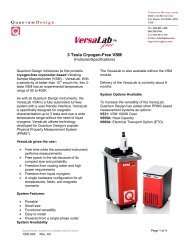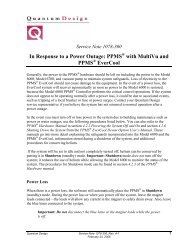Interfacing 3rd Party Instruments to the PPMS Software Environment
Interfacing 3rd Party Instruments to the PPMS Software Environment
Interfacing 3rd Party Instruments to the PPMS Software Environment
You also want an ePaper? Increase the reach of your titles
YUMPU automatically turns print PDFs into web optimized ePapers that Google loves.
<strong>PPMS</strong> Application Note 1070-202<br />
<strong>Interfacing</strong> 3 rd <strong>Party</strong> <strong>Instruments</strong> <strong>to</strong> <strong>the</strong> <strong>PPMS</strong> <strong>Software</strong><br />
<strong>Environment</strong><br />
One of <strong>the</strong> key features of <strong>the</strong> Quantum Design <strong>PPMS</strong> is its capability <strong>to</strong> interface <strong>the</strong> au<strong>to</strong>mated<br />
<strong>PPMS</strong> MultiVu software with user created application programs. This application note describes<br />
how a user’s program can respond <strong>to</strong> advisories and access third party instruments. At this time,<br />
Quantum Design has created template programs using Borland’s Delphi TM , Visual Basic, and<br />
Visual C++, which will simplify <strong>the</strong> process of receiving advisories. This application note<br />
provides <strong>PPMS</strong> users with a tu<strong>to</strong>rial introducing <strong>the</strong> basic concepts using Delphi <strong>to</strong> receive<br />
advisories and provides a general understanding of how system interfacing can be done on <strong>the</strong><br />
<strong>PPMS</strong>.<br />
It should be noted that this application note IS NOT a substitute for learning Delphi nor<br />
understanding how <strong>to</strong> perform general instrument interface using GPIB. We assume that you are<br />
familiar with both subject areas and that you only need <strong>the</strong> specific information pertaining <strong>to</strong> <strong>the</strong><br />
<strong>PPMS</strong> software. This application note only provides general guidelines in understanding <strong>the</strong><br />
linking procedures for <strong>the</strong> <strong>PPMS</strong>.<br />
Note: <strong>the</strong> <strong>PPMS</strong> also has <strong>the</strong> ability <strong>to</strong> trigger third party instruments using <strong>the</strong><br />
“Digital Line Set”, “External Select Output Line”, or “Signal Output”<br />
commands from <strong>the</strong> sequence edi<strong>to</strong>r. The Digital Line Set provides +24 volts. The<br />
External Select Output Line provides a TTL switch. The Signal Output sets <strong>the</strong><br />
specified BNC connec<strong>to</strong>r <strong>to</strong> a certain fixed output voltage. This allows –10 V <strong>to</strong><br />
+10 V feedback <strong>to</strong> o<strong>the</strong>r instruments or connection <strong>to</strong> chart recorders,<br />
oscilloscopes, and so on. Refer <strong>to</strong> <strong>the</strong> <strong>PPMS</strong> Hardware Manual for fur<strong>the</strong>r<br />
information on using <strong>the</strong> external outputs found in <strong>the</strong> rear of <strong>the</strong> Model 6000.<br />
Quantum Design <strong>PPMS</strong> Application Note 1070-202 B 1<br />
04/09/2002
Tu<strong>to</strong>rial 1: <strong>Interfacing</strong> User <strong>Software</strong> <strong>to</strong> <strong>the</strong> <strong>PPMS</strong>:<br />
Advisories:<br />
The main features of <strong>the</strong> <strong>PPMS</strong> software is <strong>to</strong> give linking capabilities, which makes it possible<br />
for <strong>the</strong> users <strong>to</strong> connect <strong>the</strong>ir program <strong>to</strong> <strong>the</strong> <strong>PPMS</strong> software without having <strong>to</strong> rewrite <strong>the</strong> <strong>PPMS</strong><br />
source code. The linking process is done through what are termed <strong>PPMS</strong> advisories. An advisory<br />
is used when <strong>the</strong> <strong>PPMS</strong> software needs <strong>to</strong> send out a flag throughout <strong>the</strong> network of running<br />
programs such that any program set up <strong>to</strong> accept advisories can catch <strong>the</strong>m. Thus <strong>the</strong> advisories<br />
act as a software trigger <strong>to</strong> initiate certain functions of an external application program.<br />
The program language chosen by Quantum Design in this Application Note is Delphi. The<br />
Delphi application development environment was chosen for its ease of use and its universal<br />
acceptance as a standard applications software language. Delphi takes full advantage of<br />
Windows capabilities and is popular among many interface developers. <strong>Interfacing</strong> <strong>the</strong> <strong>PPMS</strong><br />
software with <strong>the</strong> Model 6000 is done via <strong>the</strong> IEEE - 488 General Purpose Interface Bus (GPIB).<br />
Third party GPIB instruments can be daisy-chained <strong>to</strong> <strong>the</strong> <strong>PPMS</strong> using a standard GPIB interface<br />
cable. The GPIB address of <strong>the</strong> Model 6000 (default 15) can be determined from its front panel<br />
by looking at <strong>the</strong> config #3 selection (see <strong>PPMS</strong> User’s manual for more detail). Third party<br />
instruments connected <strong>to</strong> <strong>the</strong> <strong>PPMS</strong> must have a GPIB address different <strong>to</strong> that of <strong>the</strong> Model<br />
6000 and <strong>the</strong> Model 6500 (default 14). Third <strong>Party</strong> RS-232 instruments can be connected <strong>to</strong><br />
COM1 or Com2 port at <strong>the</strong> rear of <strong>the</strong> PC.<br />
The basic format of <strong>the</strong> <strong>PPMS</strong> software architecture revolves around its modular design. Since<br />
<strong>the</strong> Windows operating system makes software multi-tasking possible, different software<br />
“modules” can be run in unison when performing a specific application. Such modules include<br />
<strong>the</strong> base <strong>PPMS</strong> software (<strong>PPMS</strong> MultiVu), our option software modules (such as ACMS), and<br />
utility software (such as Mon6000). Different combinations of <strong>the</strong> software modules can be<br />
chosen for each specific measurement requirement. In <strong>the</strong> case of a user-developed application,<br />
<strong>the</strong> user-software written in Delphi can also be run simultaneous <strong>to</strong> <strong>the</strong> o<strong>the</strong>r standard <strong>PPMS</strong><br />
modules. The base <strong>PPMS</strong> software will set up <strong>the</strong> necessary environment such as temperature,<br />
field, and time. Once <strong>the</strong> environment settings are reached, <strong>the</strong> <strong>PPMS</strong> sequence can be written <strong>to</strong><br />
send an advisory, which triggers <strong>the</strong> user-developed application <strong>to</strong> perform its necessary tasks.<br />
Once <strong>the</strong> applications program is finished, <strong>the</strong> <strong>PPMS</strong> sequence will change <strong>the</strong> environment <strong>to</strong><br />
<strong>the</strong> next set point. This same method is used <strong>to</strong> run our measurement applications (such as<br />
ACMS). More information about advisories is presented below.<br />
Quantum Design <strong>PPMS</strong> Application Note 1070-202 B 2<br />
04/09/2002
Receiving Advisories:<br />
Before you can start creating your interfacing software, you will need <strong>to</strong> purchase <strong>the</strong> necessary<br />
application development software. For purposes of this application note, we used Delphi 5.0.<br />
There are two versions of Delphi 5.0 available - <strong>the</strong> standard copy and <strong>the</strong> professional copy.<br />
Though <strong>the</strong> standard copy is less expensive, <strong>the</strong> professional copy does have some extra <strong>to</strong>ols<br />
that are useful. Ei<strong>the</strong>r version will allow you <strong>to</strong> interface correctly <strong>to</strong> <strong>the</strong> <strong>PPMS</strong>. (Note: Delphi<br />
6.0, which is now available, is fully compatible for this application.)<br />
The first step in linking your Delphi application software <strong>to</strong> <strong>the</strong> <strong>PPMS</strong> sequence edi<strong>to</strong>r is <strong>to</strong> give<br />
your program <strong>the</strong> ability <strong>to</strong> receive advisories from <strong>the</strong> <strong>PPMS</strong> software through <strong>the</strong> server. This<br />
capability is provided by <strong>the</strong> Quantum Design Delphi template program, which is available on<br />
our website (www.qdusa.com/resources/ppms<strong>3rd</strong>party.html). Visual Basic and Visual C++<br />
template programs and sample programs are also available on our website. Once you have<br />
installed Delphi, Visual Basic, or Visual C++ on<strong>to</strong> <strong>the</strong> <strong>PPMS</strong> computer, you can add <strong>the</strong>se files<br />
<strong>to</strong> <strong>the</strong> computer.<br />
The rest of <strong>the</strong> tu<strong>to</strong>rial will be separated in<strong>to</strong> three sections. The first section will deal with<br />
receiving advisories and sending command strings using <strong>the</strong> Delphi template program provided<br />
by Quantum Design. The second section will demonstrate receiving data strings from <strong>the</strong> Model<br />
6000. The final section will cover <strong>the</strong> process of sending and receiving strings from external<br />
instruments. As stated earlier you should already be somewhat familiar with creating programs<br />
using Delphi. If you are not familiar with <strong>the</strong> language, <strong>the</strong>re are several instructional texts<br />
available <strong>to</strong> quickly learn <strong>the</strong> language and its environment. If you are familiar with Delphi <strong>the</strong>n<br />
<strong>the</strong> following steps should be easy and straightforward.<br />
Quantum Design <strong>PPMS</strong> Application Note 1070-202 B 3<br />
04/09/2002
Hello world 1 (receiving advisories):<br />
To introduce <strong>the</strong> process of receiving advisories <strong>to</strong> trigger Delphi programs, we will start with<br />
<strong>the</strong> generic “Hello World” program. In this situation, we will have <strong>the</strong> Model 6000 send out an<br />
advisory, which will trigger <strong>the</strong> Delphi Program <strong>to</strong> print a “Hello World!” text on <strong>the</strong> computer<br />
moni<strong>to</strong>r. This program will be kept very simple so that you can quickly get an understanding of<br />
how <strong>the</strong> Delphi template program accepts advisories. To create this program, follow <strong>the</strong> step-bystep<br />
procedures given below. We will explain <strong>the</strong> details of <strong>the</strong> program after <strong>the</strong> procedures.<br />
• Start Delphi.<br />
Delphi will open with several windows on <strong>the</strong> Desk<strong>to</strong>p. These windows include <strong>the</strong> Form<br />
Designer, Code Edi<strong>to</strong>r, Object Inspec<strong>to</strong>r and <strong>the</strong> Toolbar. Close <strong>the</strong> current Form (form1)<br />
and Code Edi<strong>to</strong>r (unit1.pas).<br />
• Select “Open Project” from <strong>the</strong> “Files” menu. Open <strong>the</strong> Quantum Design project1.dpr file<br />
that you downloaded from our website.<br />
Delphi will respond by displaying <strong>the</strong> <strong>PPMS</strong> Commands Form and <strong>the</strong> unit1.pas template<br />
on <strong>the</strong> desk<strong>to</strong>p. (See Figure 1).<br />
Figure 1. Delphi template program.<br />
Quantum Design <strong>PPMS</strong> Application Note 1070-202 B 4<br />
04/09/2002
• Click on <strong>the</strong> unit1.pas window. The Code Edi<strong>to</strong>r begins with <strong>the</strong> declaration of several<br />
variables and is set-up <strong>to</strong> receive advisories. As you scroll down through <strong>the</strong> code, you<br />
will get <strong>to</strong> <strong>the</strong> section where <strong>the</strong>re is a holdoff command that will send a command <strong>to</strong> <strong>the</strong><br />
Model 6000 <strong>to</strong> pause <strong>the</strong> sequence as it executes <strong>the</strong> application code for your external<br />
instrument. This feature gives <strong>the</strong> ability <strong>to</strong> put <strong>the</strong> Model 6000 in a stationary state while<br />
<strong>the</strong> application is being run. Following <strong>the</strong> holdoff command <strong>the</strong>re is a comment block<br />
stating were <strong>to</strong> put <strong>the</strong> third party application code. This is where we will add <strong>the</strong> code<br />
for our “Hello World!” program. Type <strong>the</strong> following code in this section (See Figure 2):<br />
ShowMessage (‘Hello World!’);<br />
Note: At <strong>the</strong> end of this section of code ano<strong>the</strong>r command string is sent <strong>to</strong> <strong>the</strong> Model<br />
6000 <strong>to</strong> release <strong>the</strong> holdoff. This will bring <strong>the</strong> Model 6000 out of its stationary state and<br />
it will continue <strong>the</strong> rest of <strong>the</strong> <strong>PPMS</strong> sequence. For a fur<strong>the</strong>r description of Holdoff<br />
commands or o<strong>the</strong>r <strong>PPMS</strong> command strings, see <strong>PPMS</strong> GPIB commands in <strong>the</strong> User’s<br />
manual.<br />
Figure 2. “Hello World!” program code.<br />
• Run <strong>the</strong> program. There should be no errors and <strong>the</strong> run but<strong>to</strong>n will be grayed out<br />
indicating that <strong>the</strong> program is currently running.<br />
Quantum Design <strong>PPMS</strong> Application Note 1070-202 B 5<br />
04/09/2002
• Go <strong>to</strong> <strong>PPMS</strong> sequence edi<strong>to</strong>r and create a single line sequence “advise 101”.<br />
Under Advance Commands in <strong>the</strong> sequence command menu, select Advise.<br />
This will prompt you <strong>to</strong> enter an advisory number. Enter “101” as an<br />
advisory number.<br />
• Save <strong>the</strong> sequence as “Advisorytest”.<br />
• Decrease <strong>the</strong> size of <strong>the</strong> <strong>PPMS</strong> MultiVu window so that you can see <strong>the</strong> Delphi windows<br />
also. Run <strong>the</strong> “Advisorytest”sequence.<br />
When you run <strong>the</strong> sequence you will see <strong>the</strong> front panel <strong>to</strong> <strong>the</strong> <strong>PPMS</strong> model 6000 send out <strong>the</strong><br />
command “Advise101”. Immediately you will see that <strong>the</strong> <strong>PPMS</strong> Command Form receives <strong>the</strong><br />
advisory 101 and a window will appear with “Hello World!” on <strong>the</strong> computer moni<strong>to</strong>r. Click <strong>the</strong><br />
OK but<strong>to</strong>n <strong>to</strong> close <strong>the</strong> window and resume <strong>the</strong> sequence.<br />
This simple program gives you <strong>the</strong> first step of understanding how <strong>the</strong> advisories work. First, we<br />
set up a program <strong>to</strong> display “Hello World!” in Delphi. The template program acts as an input<br />
device <strong>to</strong> receive advisories from <strong>the</strong> <strong>PPMS</strong> sequence through <strong>the</strong> server. This program also<br />
illustrates <strong>the</strong> input/output capabilities between Delphi and <strong>the</strong> <strong>PPMS</strong> server by sending<br />
individual holdoff commands <strong>to</strong> <strong>the</strong> Model 6000. We <strong>the</strong>n set up a single line sequence in <strong>the</strong><br />
<strong>PPMS</strong> <strong>to</strong> send out an advisory. When <strong>the</strong> template program received <strong>the</strong> advisory of 101, <strong>the</strong><br />
program wrote “Hello World!” in <strong>the</strong> textbox. By including your application code in place of <strong>the</strong><br />
“Hello World!” you can set up an applications program so that it will execute when <strong>the</strong> template<br />
program receives advisories.<br />
Quantum Design <strong>PPMS</strong> Application Note 1070-202 B 6<br />
04/09/2002
Goodbye World (Receiving Multiple Advisories)<br />
The following example shows you how events in <strong>the</strong> Delphi program can be triggered by<br />
different advisories. You can tailor <strong>the</strong> program and <strong>the</strong> properties of <strong>the</strong> template program so<br />
that only certain functions are triggered by one advisory while o<strong>the</strong>r functions are triggered by<br />
different advisories. This versatility in <strong>the</strong> use and adaptation of advisories gives <strong>the</strong> user <strong>the</strong><br />
capability of creating complex programs using <strong>the</strong> <strong>PPMS</strong> sequence edi<strong>to</strong>r and Delphi programs.<br />
• Close <strong>the</strong> <strong>PPMS</strong> Command Form <strong>to</strong> s<strong>to</strong>p running <strong>the</strong> program.<br />
• In <strong>the</strong> same section as <strong>the</strong> previous example, replace <strong>the</strong> “Hello World!” code in<br />
unit1.pas with <strong>the</strong> following code:<br />
if wP = 101 <strong>the</strong>n<br />
ShowMessage (Hello World!);<br />
If wP = 102 <strong>the</strong>n<br />
ShowMessage (Goodbye World!);<br />
• Run <strong>the</strong> program.<br />
• Now run <strong>the</strong> “Advisorytest” sequence.<br />
The same will happen as in <strong>the</strong> previous example. The <strong>PPMS</strong> will send <strong>the</strong><br />
Advise 101 and <strong>the</strong> “Hello World!” window will appear. Once you click<br />
OK, <strong>the</strong> window will disappear and <strong>the</strong> sequence will resume. Note: <strong>the</strong><br />
code for “Goodbye World!” was not executed. The template program was<br />
written <strong>to</strong> display “Goodbye World!” only when it received an advise 102<br />
from <strong>the</strong> model 6000. In this situation <strong>the</strong> template program only received<br />
an advise 101 which triggered <strong>the</strong> “Hello World!” text.<br />
• Go <strong>to</strong> <strong>the</strong> <strong>PPMS</strong> sequence edi<strong>to</strong>r and add “Advise 102” <strong>to</strong> <strong>the</strong> “Advisorytest” sequence.<br />
Set advise number 101<br />
Set advise number 102<br />
End sequence<br />
• Save and Run <strong>the</strong> Sequence. Again <strong>the</strong> “Hello World!” window opens when <strong>the</strong> advisory<br />
101 is sent. Once you click OK, <strong>the</strong> <strong>PPMS</strong> will send <strong>the</strong> “advise 102” command, which<br />
will display ano<strong>the</strong>r window, “Goodbye World!”. Click OK <strong>to</strong> close <strong>the</strong> window and<br />
resume <strong>the</strong> sequence.<br />
Quantum Design <strong>PPMS</strong> Application Note 1070-202 B 7<br />
04/09/2002
These two example programs illustrate <strong>the</strong> effect of using advisories. Advisories are essential in<br />
making <strong>the</strong> <strong>PPMS</strong> sequence work properly with <strong>the</strong> user created software. The combination of<br />
receiving advisories by <strong>the</strong> template program, <strong>the</strong> manual holdoff command <strong>to</strong> pause <strong>the</strong> model<br />
6000 and <strong>the</strong> advisory capabilities of <strong>the</strong> <strong>PPMS</strong> sequence edi<strong>to</strong>r makes it possible <strong>to</strong> link <strong>the</strong><br />
user’s Delphi software with <strong>the</strong> au<strong>to</strong>mated capabilities of <strong>the</strong> <strong>PPMS</strong>.<br />
GetDat for data acquisition from <strong>the</strong> model 6000:<br />
The previous section showed <strong>the</strong> methods necessary <strong>to</strong> handle advisories from Delphi. The next<br />
example will bring <strong>the</strong> program closer <strong>to</strong> a true data acquisition program. In this example <strong>the</strong><br />
“Hello World!” program will be re-written <strong>to</strong> query <strong>the</strong> data from <strong>the</strong> model 6000.<br />
• S<strong>to</strong>p <strong>the</strong> unit1.pas program. Replace <strong>the</strong> “Hello World!” and <strong>the</strong> “Goodbye World” with<br />
<strong>the</strong> following code:<br />
• Run <strong>the</strong> program.<br />
If wP = 101 <strong>the</strong>n<br />
SendPpmsCommand (‘GetDat? 2’, reply);<br />
Memo1.Lines.Add (reply);<br />
ShowMessage (‘TEMP: ‘ + reply);<br />
If wP = 102 <strong>the</strong>n<br />
SendPpmsCommand(‘GetDat? 4’, reply);<br />
Memo1.Lines.Add (reply);<br />
ShowMessage(‘FIELD: ‘ + reply);<br />
• Run <strong>the</strong> “Advisorytest” sequence.<br />
//sends command string &<br />
//retrieves data string<br />
//display data string on form<br />
//display data string on window<br />
When <strong>the</strong> sequence is started, <strong>the</strong> Model 6000 sends <strong>the</strong> Advise 101 command. From <strong>the</strong> <strong>PPMS</strong><br />
Command form, you will see that <strong>the</strong> program receives <strong>the</strong> advisory and <strong>the</strong>n displays a string of<br />
three numbers separated by commas. Then a window will appear on <strong>the</strong> computer moni<strong>to</strong>r<br />
showing “TEMP: “ and <strong>the</strong> same string of numbers. The third number at <strong>the</strong> far right is <strong>the</strong><br />
temperature of <strong>the</strong> <strong>PPMS</strong>. You can verify by comparing it with temperature shown on <strong>the</strong> Model<br />
6000 front panel. The first two numbers are <strong>the</strong> bit flag (2) and <strong>the</strong> timestamp, which appear on<br />
all GetDat queries. When you press <strong>the</strong> OK but<strong>to</strong>n, <strong>the</strong> sequence resumes and sends <strong>the</strong> Advise<br />
102 command. The <strong>PPMS</strong> Command Form will receive <strong>the</strong> advisory and display ano<strong>the</strong>r string<br />
of data. A window will appear on <strong>the</strong> computer moni<strong>to</strong>r with “Field: “ and <strong>the</strong> same string of<br />
data. The third number is <strong>the</strong> present field measured in Oersteds. Click <strong>the</strong> OK but<strong>to</strong>n <strong>to</strong> end <strong>the</strong><br />
sequence.<br />
The data program demonstrates <strong>the</strong> use of a data window. Unlike <strong>the</strong> “Hello World!” program,<br />
which only printed <strong>the</strong> “Hello World!” message during <strong>the</strong> advisory, <strong>the</strong> Data program actually<br />
Quantum Design <strong>PPMS</strong> Application Note 1070-202 B 8<br />
04/09/2002
queried <strong>the</strong> Model 6000 for <strong>the</strong> system temperature and magnetic field state. This was done<br />
using <strong>the</strong> GetDat command. The type of data obtained from <strong>the</strong> model 6000 depends on <strong>the</strong> bit<br />
flag suffix you attach <strong>to</strong> <strong>the</strong> GetDat command. For example, <strong>the</strong> bit flag for <strong>the</strong> temperature is 2,<br />
while <strong>the</strong> bit flag for <strong>the</strong> field is 4. If you want <strong>to</strong> receive both values at once you can specify <strong>the</strong><br />
bit flag of 6 <strong>to</strong> <strong>the</strong> GetDat. The list of bit flags specific <strong>to</strong> each data item is given in <strong>the</strong> <strong>PPMS</strong><br />
User’s manual. Remember that all responses will au<strong>to</strong>matically include <strong>the</strong> bit flag and<br />
timestamp.<br />
Once <strong>the</strong> Delphi program has received <strong>the</strong> data string from <strong>the</strong> Model 6000, you can manipulate<br />
it using <strong>the</strong> standard Delphi routines (Once again we suggest you get a book on Delphi if you are<br />
not familiar with <strong>the</strong> language). For your particular application, <strong>the</strong> data can be transferred <strong>to</strong> a<br />
more permanent variable (such as Temp and Field) and s<strong>to</strong>red in a file using standard Delphi file<br />
access. In this way, you can receive data from o<strong>the</strong>r instruments via <strong>the</strong> GPIB while retrieving<br />
<strong>PPMS</strong> information using <strong>the</strong> server and commands (such as GetDat). For more information on<br />
<strong>the</strong> GetDat and o<strong>the</strong>r <strong>PPMS</strong> command strings, reference <strong>the</strong> <strong>PPMS</strong> User’s manual.<br />
<strong>Interfacing</strong> <strong>to</strong> O<strong>the</strong>r <strong>Instruments</strong><br />
IEEE GPIB Bus<br />
The <strong>PPMS</strong> uses a National <strong>Instruments</strong> GPIB board <strong>to</strong> provide communication <strong>to</strong> <strong>the</strong> Model<br />
6000. The GPIB bus controller resides within <strong>the</strong> HP computer while <strong>the</strong> Model 6000 GPIB acts<br />
as a slave board for input/output or I/O (similar <strong>to</strong> any o<strong>the</strong>r third party instrument with GPIB<br />
capability). Thus, for third party instruments that are connected in parallel <strong>to</strong> <strong>the</strong> Model 6000,<br />
<strong>the</strong> user can interface <strong>to</strong> <strong>the</strong>se instruments by using <strong>the</strong> standard methods for a National<br />
<strong>Instruments</strong> board.<br />
To interface your software with third party GPIB instruments, you need <strong>to</strong> send <strong>the</strong> proper<br />
National <strong>Instruments</strong> commands from Delphi. The support of such an interface is provided by<br />
National <strong>Instruments</strong> using <strong>the</strong> Dynamic Link Library (DLL). This necessitates learning <strong>the</strong><br />
command syntax of <strong>the</strong> third party instrument. To talk <strong>to</strong> an instrument, your application<br />
program must send <strong>the</strong> correct command strings <strong>to</strong> <strong>the</strong> appropriate instrument and have it receive<br />
<strong>the</strong> data string back from that instrument. If you have never used <strong>the</strong> National <strong>Instruments</strong> GPIB<br />
library <strong>to</strong> send command strings <strong>to</strong> outside instruments, you should start by reading <strong>the</strong> manuals<br />
for <strong>the</strong> National <strong>Instruments</strong> GPIB board (available from National <strong>Instruments</strong>) and <strong>the</strong> GPIB<br />
programming section in <strong>the</strong> manual for <strong>the</strong> device you wish <strong>to</strong> use (should be provided by <strong>the</strong><br />
instrument’s manufacturer). The National <strong>Instruments</strong> manual gives <strong>the</strong> standard command lines<br />
available for controlling <strong>the</strong> GPIB bus. Examples of such commands include “ibwrt” which<br />
sends a command string <strong>to</strong> an instrument and “ibrd” which receive information. You will also<br />
need <strong>to</strong> know <strong>the</strong> GPIB address of <strong>the</strong> instrument with which you wish <strong>to</strong> communicate. To<br />
familiarize yourself with sending National <strong>Instruments</strong>’ command strings <strong>to</strong> an external<br />
instrument (such as a Hewlett Packard multimeter), connect <strong>the</strong> GPIB port of <strong>the</strong> instrument <strong>to</strong><br />
<strong>the</strong> Model 6000 GPIB connection. Test <strong>the</strong> GPIB communications by sending single line<br />
commands <strong>to</strong> <strong>the</strong> instrument. For example, you might try <strong>to</strong> put <strong>the</strong> instrument in<strong>to</strong> remote mode<br />
Quantum Design <strong>PPMS</strong> Application Note 1070-202 B 9<br />
04/09/2002
or retrieve data from it. When you have learned <strong>to</strong> control and retrieve data from your instrument<br />
using command strings via <strong>the</strong> GPIB, you can write <strong>the</strong> command strings in<strong>to</strong> your application<br />
programs. Then by linking your application programs <strong>to</strong> <strong>the</strong> au<strong>to</strong>mated <strong>PPMS</strong> temperature and<br />
magnetic field control system, you can au<strong>to</strong>mate complex measurements and sequences. You<br />
should, of course, consult <strong>the</strong> programming section of your third party device <strong>to</strong> understand its<br />
GPIB pro<strong>to</strong>col and instrument specific command strings. The user will still be responsible for<br />
creating <strong>the</strong> software, however with <strong>the</strong> template program as an example, you can create your<br />
own applications programs <strong>to</strong> receive advisories and communicate with <strong>the</strong> Model 6000.<br />
IEEE RS-232 Bus<br />
To interface <strong>the</strong> software <strong>to</strong> <strong>the</strong> third party RS-232 instrument, one would have <strong>to</strong> send <strong>the</strong><br />
proper RS-232 command from Delphi. Windows using <strong>the</strong> file input/output library and <strong>the</strong><br />
communications library provides <strong>the</strong> support of such an interface. This necessitates learning <strong>the</strong><br />
command syntax of <strong>the</strong> third party instrument. To talk <strong>to</strong> an instrument, your application<br />
program must send <strong>the</strong> correct command string <strong>to</strong> <strong>the</strong> appropriate instrument and have it receive<br />
<strong>the</strong> data string back from that instrument. If you have never used <strong>the</strong> Windows communication<br />
interface <strong>to</strong> send command strings <strong>to</strong> outside instruments, you should start by reading <strong>the</strong><br />
documentation for <strong>the</strong> communications library (available from Microsoft).<br />
Summary of <strong>PPMS</strong> links:<br />
This application note has shown you how <strong>to</strong> link Delphi programs <strong>to</strong> <strong>PPMS</strong> sequences using<br />
advisories. The Data program also showed how data could be retrieved from <strong>the</strong> Model 6000 by<br />
your applications program. Using <strong>the</strong>se simple <strong>to</strong>ols you can now write application programs<br />
that can be triggered from <strong>the</strong> <strong>PPMS</strong> advisories <strong>to</strong> retrieve and s<strong>to</strong>re relevant <strong>PPMS</strong> data in<strong>to</strong><br />
your own file. The <strong>PPMS</strong> sequence capability combined with <strong>the</strong> Delphi, Visual Basic, or <strong>the</strong><br />
Visual C++ template programs and <strong>the</strong> GPIB interface give you <strong>the</strong> capability <strong>to</strong> create<br />
au<strong>to</strong>mated sequences for your own specific applications. By studying <strong>the</strong> <strong>PPMS</strong> User’s manual,<br />
<strong>the</strong> Delphi, Visual Basic, or Visual C++ reference guides, and your instrument’s GPIB manual,<br />
you should be able <strong>to</strong> write complex programs, which can link your measurement operations <strong>to</strong><br />
<strong>the</strong> <strong>PPMS</strong> au<strong>to</strong>mated control system.<br />
Quantum Design <strong>PPMS</strong> Application Note 1070-202 B 10<br />
04/09/2002
Appendix<br />
Additional information regarding <strong>PPMS</strong> applications programming<br />
1. Additional Information about GetDat<br />
The GetDat query, unlike <strong>the</strong> Measure query, directly requests <strong>the</strong> system for information<br />
without placing it in<strong>to</strong> <strong>the</strong> data memory buffer in <strong>the</strong> Model 6000. The GetDat command queries<br />
<strong>the</strong> Model 6000 for information and immediately sends this back <strong>to</strong> <strong>the</strong> server. In contrast, when<br />
a Measure command is sent <strong>to</strong> <strong>the</strong> Model 6000, it will create <strong>the</strong> appropriate string and s<strong>to</strong>re it in<br />
its internal memory, without sending it back <strong>to</strong> <strong>the</strong> server. Thus, <strong>the</strong> measure command is a<br />
specific type of GetDat, which s<strong>to</strong>res <strong>the</strong> queried information in <strong>the</strong> internal buffers of <strong>the</strong> Model<br />
6000. Independent of <strong>the</strong>se specific queries, <strong>the</strong> Model 6000 is continuing <strong>to</strong> update its internal<br />
information so that when it is queried, this information is current. Some of this information is<br />
always being updated (such as <strong>the</strong> temperature) while o<strong>the</strong>rs are only updated when <strong>the</strong>y are<br />
configured (such as <strong>the</strong> user bridge channels). Thus, whenever a GetDat query is sent <strong>to</strong> <strong>the</strong><br />
Model 6000, <strong>the</strong>re should be no additional information filling up <strong>the</strong> Model 6000's internal<br />
memory buffer. This is why <strong>the</strong> data % on <strong>the</strong> front screen of <strong>the</strong> Model 6000 does not increase<br />
as you ask for more data using GetDat.<br />
Depending on <strong>the</strong> type of GetDat query, one may run in<strong>to</strong> a timing problem between <strong>the</strong> GetDats<br />
and <strong>the</strong> internal information updates <strong>to</strong> <strong>the</strong> Model 6000. A typical GetDat waits for <strong>the</strong> <strong>PPMS</strong> <strong>to</strong><br />
update all appropriate information and <strong>the</strong>n retrieves <strong>the</strong> information back <strong>to</strong> <strong>the</strong> server. Most of<br />
<strong>the</strong> internal information (such as temperature) updates relatively quickly. However o<strong>the</strong>r<br />
information (such as <strong>the</strong> user bridge signals) can take some time depending on <strong>the</strong> experimental<br />
conditions. For example, for <strong>the</strong> user bridge, <strong>the</strong>re are three modes of operation; <strong>the</strong> fast mode,<br />
<strong>the</strong> standard mode and high-resolution mode. In <strong>the</strong> fast mode <strong>the</strong> Model 6000 will immediately<br />
respond <strong>to</strong> a query by giving whatever voltage is being read from <strong>the</strong> appropriate channel. In <strong>the</strong><br />
standard mode, <strong>the</strong> Model 6000 will compare <strong>the</strong> sample signal with a set of internal precision<br />
calibration resis<strong>to</strong>rs for a more accurate reading. In <strong>the</strong> high-resolution mode, <strong>the</strong> Model 6000<br />
will do several standard mode measurements and average <strong>the</strong> result. Fur<strong>the</strong>rmore, in <strong>the</strong> highresolution<br />
mode, <strong>the</strong> number of measurements <strong>to</strong> average increases as <strong>the</strong> resistance of <strong>the</strong><br />
sample decreases. Thus in <strong>the</strong> worst case scenario, if you have all three bridge channels<br />
measuring in <strong>the</strong> high resolution mode on samples having low resistances that are quickly<br />
changing (demanding better feedback current control), such measurements require some time <strong>to</strong><br />
update (up <strong>to</strong> several seconds). This may result in a GPIB timeout and you may get a command<br />
error. Thus one should always be careful about <strong>the</strong> timing of <strong>the</strong> queries <strong>to</strong> <strong>the</strong> type of request<br />
given <strong>to</strong> <strong>the</strong> Model 6000.<br />
Quantum Design <strong>PPMS</strong> Application Note 1070-202 B 11<br />
04/09/2002
2. IEEE-488.2 Recommendation<br />
Depending on <strong>the</strong> type of instrument being connected <strong>to</strong> <strong>the</strong> GPIB bus, one may encounter<br />
problems with incomplete GPIB pro<strong>to</strong>cols from <strong>the</strong> third party instrument. Although many<br />
instruments state GPIB compatibility, not all GPIB capabilities are <strong>the</strong> same. The current<br />
accepted GPIB pro<strong>to</strong>col is IEEE-488.2; <strong>the</strong> <strong>PPMS</strong> Model 6000 uses this pro<strong>to</strong>col. O<strong>the</strong>r<br />
instruments (especially older models) may only be following <strong>the</strong> IEEE-488.1 or older pro<strong>to</strong>col.<br />
The result of having incomplete pro<strong>to</strong>cols may result in <strong>the</strong> lock up of <strong>the</strong> GPIB bus such that a<br />
complete GPIB reset becomes necessary <strong>to</strong> release <strong>the</strong> network. If you feel that you may be<br />
having GPIB problems with your program, you can test whe<strong>the</strong>r <strong>the</strong> problem is due <strong>to</strong> GPIB<br />
pro<strong>to</strong>col by modifying your programs so that <strong>the</strong>y are still performing communications <strong>to</strong> <strong>the</strong><br />
Model 6000 but are not querying <strong>the</strong> third party instruments. You should also physically<br />
disconnect <strong>the</strong> instrument from <strong>the</strong> GPIB network. If <strong>the</strong> modified program runs, when <strong>the</strong> third<br />
party instrument is physically disconnected and masked from <strong>the</strong> program, <strong>the</strong>n <strong>the</strong>re may be<br />
problems with <strong>the</strong> third party instrument. If you have several instruments connected <strong>to</strong> <strong>the</strong> GPIB<br />
bus, you may want <strong>to</strong> do this with each instrument until you find <strong>the</strong> instrument at fault.<br />
Fur<strong>the</strong>rmore, <strong>the</strong>re are several universal command strings, which all IEEE-488.2 instruments<br />
accept (such as *IDN?). If <strong>the</strong> instrument being used is an IEEE-488.2 system it should respond<br />
<strong>to</strong> <strong>the</strong>se universal commands. In summary, if you interface instruments using IEEE-488.1 or<br />
older pro<strong>to</strong>col, you should take care when writing your program for proper communication.<br />
3. Command Strings and Sequences<br />
When <strong>the</strong> Model 6000 is running a sequence, any resources being used by <strong>the</strong> sequence becomes<br />
unavailable for interactive operation. For example when <strong>the</strong> Model 6000 is performing a scan H<br />
sequence, <strong>the</strong> application program cannot send a command string <strong>to</strong> <strong>the</strong> Model 6000 <strong>to</strong> change<br />
<strong>the</strong> field. Conversely, any environment resources not being controlled by <strong>the</strong> sequence remains<br />
available <strong>to</strong> <strong>the</strong> user for interactive operation. Of course any read-only parameters (such as<br />
GetDat?) can be obtained using command strings, even when it is being used in <strong>the</strong> sequence.<br />
Quantum Design <strong>PPMS</strong> Application Note 1070-202 B 12<br />
04/09/2002


